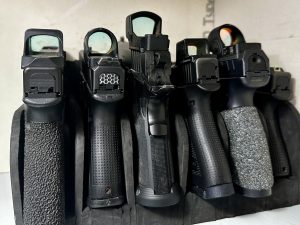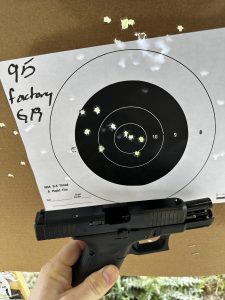Red Dots on Pistols Aren’t for Everyone

As of today, May 19, 2024, I have a little over 6 continuous years of RDS (red dot sight, which is just the industry term for electronic optical sights) equipped pistols. While I've been exposed to, competed with, and even carried some rds equipped pistols since 2013, it wasn't until the beginning of 2018 that I began giving them a more serious role in competing and teaching.
In the last 6 years I have taught a few hundred students, mostly civilian but quite a bit of active LE/mil as well. These students were mostly of the intermediate level of skill, meaning they were competent in safety, sight/target alignment, and manipulations. I would say 1/4 of the students I've taught were of the beginner level, meaning they were not familiar with range etiquette, drawing safely, or sometimes even basic manipulations.
To add to the relevancy and integrity of this data based report, I have received letters of recommendation from Grand Master competitors and active LE SWAT. The following data will be as objective as possible, but you must consider the fact that I am a shooting coach, therefore much of what I do and say is subjective by nature, although never without the intent of bettering the student. My background is mostly teaching/coaching based and I do not claim any professional experience beyond that. My short time as a MP yielded no relevant experience. My many years of part time and some full time private security and EP (executive protection) only yielded perspective and context.
Now on to what you came here for. The “too long, didn't read” synopsis of this is fairly simple. I do not think rds equipped pistols are for people who do not practice and/or never intend to practice. This opinion comes from seeing lots of people struggle to “find the dot”, resulting in slower presentations, transitions, and sight acquisition after manipulations and movement. Similar to active safeties, it's an extra level of tasks that must be completed before firing, and without practice, that has proven to be a liability more so than an asset.
How about some deeper context? These people I just referenced are the 99% of gun owners. These folks have taken their permit class mandated by the state they reside in (or not, because some states are permitless or Constitutional Carry) and will never take another class, compete, or even dry fire practice. Unfortunately I've taught LE only classes that had officers fitting this bill perfectly. A superior sighting system will never do these people any good, and in most cases it's just a hinderance.
Don't worry, I will include all of the positives of rds's and include some personal data. First though, let's also take in consideration the economics of this. Dependable RDS's can range from $350 all the way up to the ridiculous costs of the Aimpoint ACRO which hits the wallet at $600, the Trijicon RMR HD and RCR at $650, and the Sig Romeo2 at $650. Do you really get your money's worth from putting the cost of an additional service pistol on top of your existing pistol? Well, shooters like me do. Let's talk about why.
The 10-10-10 Test and 25 yard B-8 are excellent tests for this. Now, full transparency, I have way more data shooting those two exercises with rds equipped pistols than I do iron sighted pistols, but I do have 2 very recent iron sighted examples to pull from, one even being with a 2011 which is arguably easier to shoot and more accurate.
The first picture is just to show how much of the target is covered by the gun itself when using only iron sights. There's something to be said about the need for target awareness, and as you can see, you don't get much of that once you get past 15 yards. An optic would reveal much more of the target. (I apologize for the lack of image illustration, pictures really don't do this justice) The second picture shows the result of a 10-10-10 with that super sweet shooting 2011 (it's actually a springfield prodigy 1911ds, but 2011 has always been the industry terminology, even after Stacatto trade marked “2011”). As you can see, that's a 100 score, so you may be thinking that irons are perfectly fine. Well, you're right, they absolutely get the job done, especially in the hands of a well developed shooter like myself. Here's the kicker, even at my level, it's still considerably easier to do with an optic.


Let's move on to a more realistic example. Two Glock 19's, arguably the most prolific carried pistol in the US, and still to this day a go-to choice for me. The first picture is a 10-10-10 with my personal g19 with a holosun 407c (a budget friendly and reliable choice, although I now prefer the holosun EPS and EPS carry as they are enclosed emitters). I can almost guarantee you a 100 score on a 10-10-10 on any given day with this setup. It's only when I push for speed/time that I push shots out of the 10 ring. It really is that easy. The second picture was done on the same day, not long after that first picture. I shot that 10-10-10 at a score of 95 with a student's brand new gen5 g19. A 95 is respectable by most people's standards, but the score only tells half the story. Lets dig into that after you look at those pictures closely.


To say I had to work for that 95 would be a fair statement. As you know, the 10-10-10 is 10 shots from the draw at 10 yards within 10 seconds. If I recall correctly, I was in the low 9's for time, which for me is reactively shooting each shot. That's important to know before I explain what I saw and did during those 10 shots. The first shot was the far high/left shot. Even tho I saw a great sight alignment and gave it a respectful trigger pull, it was still over 3″ to the left. Honestly the only reason I could see the shot was because the lighting was perfect. Once I saw that, in my mind I thought I may have disrespected the trigger a bit so I gave it a few more trigger pulls and as you can see, those 3 weren't any better. Had to call an audible. I then moved my sight alignment to the right and down just a touch to try to recover some points, specifically aiming just below the number 9 on the right side. Thankfully, at my skill level, I could do exactly that, earning that score of 95. By the way, the rear iron sight was perfectly centered and the front sight had no damage. I used Pinnacle factory new 147gr at 950fps in both tests.
We should also consider that everyone doesn't have perfect vision. For example, I have no usable vision in my right eye, which means I shoot pistols right handed and rifles left, always utilizing my left eye. In my case, iron sighted pistols and the optic housing cover up even more of the target. Even people with astigmatism benefit from optics so long as they choose one that doesn't “star burst”. I've observed that green dots that are 5moa in size or larger are the ticket for this specific vision problem. If you have perfect vision in both eyes, well then happy day for you, you can see the entire target with a red/green dot superimposed over it. Congrats, you won the rds sighting lottery.
You may be thinking that this isn't much data to draw a conclusion from, and you'd be correct. The truth is this blog/report would be longer than most folks would care to read if I documented and presented every relevant drill and exercise I've done in the last year. Which is why I mentioned earlier that this would have a subjective nature. Now on to my professional opinion on what and how I've observed students of intermediate skill performing with rds equipped pistols.
What I've observed can best be described as a learning curve with time and performance. As a person's time behind a rds pistol goes up, so does their performance. For untimed or generous par time accuracy, the performance increases almost immediately. For timed and dynamic performance, the increase starts slower, but almost always surpasses that of an iron sighted gun with a reasonable amount of focused practice. Which, from what I've seen, can be accomplished within 6 months.
All of this info further begs the question, “are electronic optics on pistols worth it?”. Well, if you intend to be accountable and responsible with your defensive and/or service pistol, then absolutely. Distance shooting will become much easier. High risk shots will become less risky. Qualifying will become an absolute breeze. It's like a cheat code you can buy. So ask yourself this, how much would you pay for making the worst day of your life easier?
Lastly, we must talk a bit about maintenance. Properly mounting the optic is just the beginning. Witness marking your screws so that you can easily check daily that they are still tight, zero'ing to your duty ammo, setting a reminder on your phone for annual or bi-annual battery changes (depends on the optic, some have amazing battery life, like the RMR, and some don't, like the ACRO), making sure the brightness is always on the appropriate level (too bright is almost always better than not bright enough), and confirming zero as often as you can (it's rare the zero shifts unless unmouting or change of ammo occurs). Even with all the extra maintenance and cost that comes with optics, I still feel and observe them to be a huge benefit over irons.
Let's conclude this with my most subjective statement yet. A quality pistol with a quality optic will give a shooter of at least intermediate skill an unfair advantage over their opponent. I don't know about you, but I want every advantage I can get and for the fight to be as unfair as possible.
If you've enjoyed this blog, please consider visiting the Partners page of the website. All vendors advertised give me credit for your purchases, so long as you travel there from my site. I was a trusting customer of these vendors long before they began supporting me, and still am, so buy with confidence.

I would disagree with the title, since I believe new shooters have an advantage in learning to use an RD system as you suggest. There is no unlearn for them as there would be with long term avid iron sight users.
As a result I think they are able to grasp the concept of red dot usage much fast then old head iron folks once they are shown how to use the system.
I remember reading somewhere about an Instructors that was having students remove their RDS. Then they claimed that they were new that a the Red Dot would interfere with them learning. I think what this really meant was that he wasn’t a red dot user, and didn’t want to both teach something he knew nothing about.
I have given a newbies a pistol with a Red Dot and they totally loved it once it was explained how to use it. So I wish some folks would stop acting like new shooters are completely clueless.